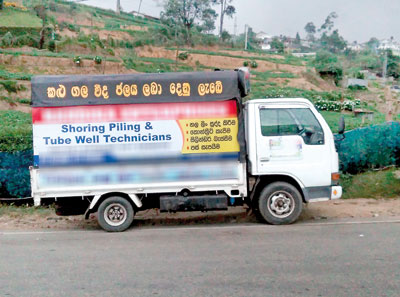News
Limits on ground water use viewed with suspicion

The vehicle of a company that instals tube wells
Local authorities have been asked to strictly enforce new regulations to prevent over extraction of ground water amid fears that water levels are declining.
But farmers suspect this is an attempt to tax water resources through regulation in the long-term.
The latest regulation which has been gazetted will be implemented island-wide to protect ground water, chairman of the Water Resources Board (WRB), A.C.M Zulficar said.
Only 30,000 litres of water per month will be allowed to be tapped from the ground.
Zulficar said ground water levels have dropped 4.5 metres below ground in the coastal areas although the normal level should be 1.5 metres below ground.
“Due to overuse of ground water in Jaffna, the water had been completely drained and sea water had seeped inland, while Puttalam is also an affected area,’’ Mr Zulficar said.
All government, local government or non-government organisations and institutions including individual users have to submit detailed reports of their water requirements as projects to obtain approval, he said.
Written permission of the WRB should be obtained for building agro wells of the depth of four metres or more, or for wells or tube wells for commercial agriculture and industry.
The industries include bottled water, beverages, hotels, livestock farms and coir and rubber industries.
Zulficar said a grace period is effective until the end of this month.
Industrial users of ground water should fix flow meters to monitor the amount of water pumped from a well, keep records of daily use, and maintain capacity.
Records should be provided to the WRB every three months, while any institute or an individual engaged in bottling water, and bottling beverages using springs, should have samples analysed by a reputable chemical laboratory every six months.
WRB only allows to extract 30,000 litres of ground water per month, for industrial, commercial, and agricultural use, Zulficar said.
“So far, we have received around 150 applications and 70 of them for digging agricultural wells, while 90 tube well miners have been registered. There are also 250 tube wells,” he said.
Additional District Secretary of Puttalam, W.M.C.K Wanninayake, said that the dry weather had forced the shift to the use of ground water.
He said that the WRB has informed them of the situation.
The Pradaeshiya Sabha has been informed and has been asked to deploy water tankers to supply water.
“We instructed our officers to implement the regulations when recommending tube wells,’’ he said.
In Nuwara Eliya, Divisional Secretary Sujeewa Bodimanna, said awareness programmes have begun.
Meanwhile, the All-Island Farmers Federation, national organiser, Namal Karunaratne, welcomed the moves to protect ground water. But farmers suspect that registration of wells is being required so that taxes can be imposed.
Mr Karunaratne said that the government should also stop illegal land filling, sand mining and also build more tanks to help preserve ground water.
He complained that while large scale beverage industries are allowed to use water others are being asked to register including tube well creators. So while actions are being taken to protect ground water, streams will be exhausted.
Environmentalist of the Biodiversity Conservation and Research Circle, Supun Lahiru Prakash, said that the ground water levels have to be preserved through the Water Resources Management act.
He said that the ground water table is a valuable resource.
Mr Prakash said that the Government should also consider the environmental impact and the pollution of the water. He said that the Government first should stop dumping garbage in marshy areas that feed the ground water.
The Government also should limit the amount of water used by industrial and commercial users who use ground water for beverages and bottled water.
He said that rather than imposing a limit of 30,000 litres a month, limits should be devised based on water volumes under ground.
| Regulation advocated for lifeblood of the poor The Colombo-headquartered International Water Management Institute, which set foot in Sri Lanka in 1984, has advocated regulation of ground water in Sri Lanka and has recommended stopping over pumping at all costs. The Water Resources Board works with the organisation and the institute does not pay taxes in Sri Lanka because it has been granted exemption. Ground water, which is a renewable source replenished by rainfall, is often extracted through thousands of agricultural wells, and is a resource that has been the lifeblood of poor farmers and households in the country for thousands of years. Farmers in the dry zone especially tap into shallow ground water resources. In the Yala season farmers are known to turn water from agricultural wells. In Sri Lanka, only 9 million out of a population of 21 million people have access to pipe-borne water. Researchers have identified six types of groundwater aquifers in Sri Lanka – the shallow karstic aquifer in the Jaffna peninsula (the peninsula is more than 1,00 square kilometres and its groundwater lies in limestone. The groundwater is replenished during the northeast monsoon from November to February); deep confined aquifers; coastal sand aquifers; alluvial aquifers; shallow regolith aquifer of the hard rock region, and the south western lateritic (cabook) aquifer. |
Additional reporting : Shelton Hettiarachchi  Â

